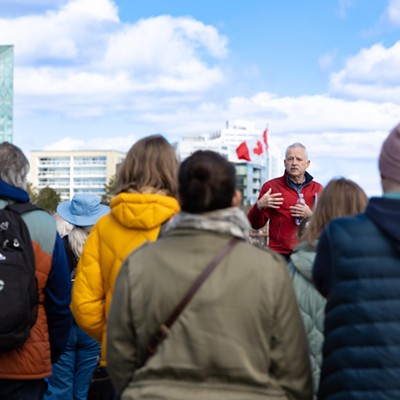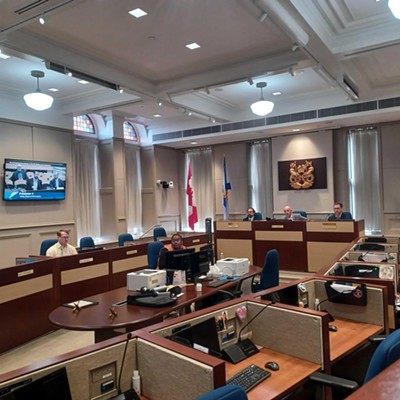On April 12 transportation minister Bill Estabrooks announced the second biggest highway capital budget in the province's history. More than $300 million is going to roads and bridges. This is how we save the economy.
In a government press release Grant Feltmate, director of the Nova Scotia Road Builders Association, noted, "In the short term, this budget will have a very large, positive economic impact." The key phrase is "short term."
In the long term we will have more expensive highways. Two of them are coming, eventually, to the HRM. "It could be 10, 15, 20 years before Highway 113 is built," says Helen MacPhail, an environmental assessment officer at the Department of Environment.
The new four-lane highway, which will buttress the Blue Mountain-Birch Cove Lakes Wilderness Area south of Hammonds Plains Road, is planned to serve an anticipated need based on projected traffic volume increases in Hammonds Plains. New developments---sprawl---could necessitate, some day, the new highway. Its implementation is so far away that it's impossible to calculate the cost, but if it were built today it would cost over $30 million.
Though the project is not yet approved politically, or funded, it just received a conditional environmental assessment approval. MacPhail says that once the wilderness area was designated last April, many of the concerns expressed by environmentalists about the highway were alleviated. "We looked at impacts on wildlife, wetlands, recreational opportunities, proximity to residences, water wells, noise and dust."
The conditions require the Department of Transportation and Infrastructure Renewal to consult with the community and other government departments, update wildlife and water well surveys and submit plans for environmental protection and mitigation.
"I don't think I'm surprised," says Chris Miller, national manager of the Canadian Parks and Wilderness Society. "Government has been trying to build this road since 1998." He adds that the provincial government has essentially wormed its way out of the more rigorous environmental assessment process required for a 10-kilometre highway, first by claiming the highway was 9.9 kilometres (it is more than that if you include overpasses), and then by getting rid of the 10-km rule. "Government always seems to get road projects through."
Miller calls the wilderness area a "big step in the right direction," but feels that rather than relieve congestion the highway will "open up the entire landscape to urban sprawl. Once there's a highway, exits appear, along with new communities and box stores. The actual decisions have to be made on traffic need and the desire of the community, and it's not a popular highway."
At the western end of Hammonds Plains Road is exit 5 of Highway 103. If you hop onto the 103, be prepared for a 22-kilometre drive before you hit exit 6. Somewhere between those two exits, TIR is planning a southbound highway connecting to St. Margarets Bay Road/Highway 3.
The two projects are eerily similar. Both have little traction with locals, murky timelines and uncertain costs. "We're planning a twinning from exit 5 to 6," says Cathy MacIsaac, a spokesperson for TIR. "The modern standard is one exit per eight to 10 kilometres, and the reason they like to have them spaced that way is to have exits for emergency vehicles."
The highway twinning is approved and funded, and should be "tender-ready" next year. Ideally, the connector road would be built at the same time, but its environmental assessment is ongoing. A public consultation process will follow in a few months.
"Government has been working on this for three years, basically in secret," says Sean Kirby, founder of a group opposing the new connector. "We only heard in February." He says the community---including the St. Margarets Bay Stewardship Association, local businesses and local MP Gerald Keddy---is overwhelmingly against the project. "This will divert traffic away from Hubbards and Tantallon." He says doing so runs counter to the Halifax Regional Plan, which designates Tantallon and Hubbards as economic hubs.
Paula Fredericks, who lives near St. Margarets Bay Road about halfway between the two exits, doesn't buy the rationale for the connector. "If access to the 103 for safety is at the forefront of this decision," she says, "why not transfer funds and enable our local fire stations to be equipped better and staffed with paid firefighters 24/7?"
Sounds like a decent way to create jobs and improve safety but, uh, maybe just a little too long-term for us at this juncture. We'll get there someday.












